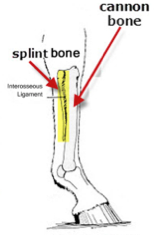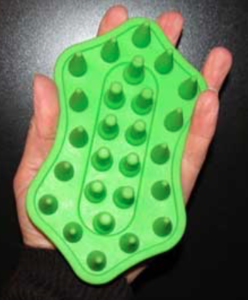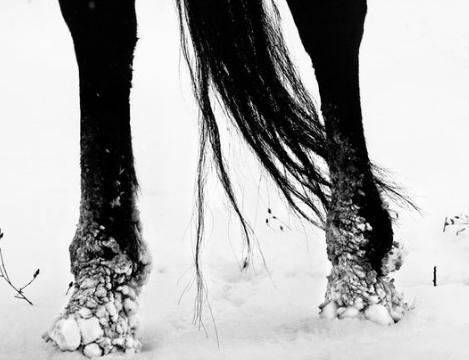By Jaclyn Amaru
Cold weather can be dangerous and take a significant toll on your horse’s health. Did you know that footing quality can greatly impact the wear and tear on your horse’s lower extremities? Chances are, if you have had your first frost by now the ground outside is near-frozen. It may appear generally acceptable to ride on, however one can very easily misjudge this. The stress and shock that your horse’s lower extremities must absorb while training on hard, unforgiving ground is huge. As a result of this stress, a condition known as splints can occur.
Splints are an inflammatory condition of the splint bones, which are found on either side of the longer cannon bone found below the knee joint. Between the cannon bone and each splint bone is an interosseous ligament known to calcify into bone as horses age. Splints occur when injury to this ligament or bone, or the soft tissues of the bones or surrounding bones occur. Splints can therefore be referred to as a bony swelling or a soft tissue swelling, but often it’s a combination of the two. Most commonly, it is the splint on the inside or medial portion of the leg, that is injured.

Usually, professional trainers and grooms can diagnose splints with just a mere exam. However, it is encouraged to obtain x-rays to confirm the diagnosis. Examination of the lower extremity will reveal symptoms of heat and swelling along the splint bone with pain to touch. The degree in lameness can vary, but is usually mild and most apparent at the trot. As the inflammation begins to resolve, local swelling will become firmer and less painful.
If you find yourself in a situation where you think your horse may have splints, be sure to have a proper evaluation with a vet. Rest is the key element for recovery, however, many adjunct therapies exist to help aid in the healing process with the goal being to reduce inflammation, the size of the splint and to relieve pain. Some of these conservative measures include cold therapy, pressure bandaging, the use of anti-inflammatory medications and pulsed magnetized therapy. In rare cases, surgery may be needed, especially if lameness does not improve.
While many of these conservative measures may have benefits in the healing spectrum, there are some drawbacks to consider.
- Cold therapy reduces inflammation, but also slows blood flow to the injured area allowing for less nutrient and oxygen-rich blood to assist with healing.
- Pressure bandaging, if not done correctly, can seriously impede blood flow to healthy tissue in the leg and hoof leaving severe implications.
- Using medications can come with a whole list of unwanted side effects.
- Therapies that utilize shock waves can speed healing time by stimulating new vessel growth do not reduce inflammation.

One therapy that does ameliorate inflammation, pain relief and stimulation of blood flow is equine massage therapy. While splints can be painful to touch initially, once the pain subsides, massage can be a very lucrative tool, in addition to rest. Massage is a tool that riders, owners, trainers, and grooms can perform themselves. Massaging the injured tissue or bone can help to reduce the size of the resulting splint. Furthermore, this modality is widely underutilized in the sense that many equestrians fail to recognize that the site of injury is not the only location under stress. The other extremities, having to compensate for a sore leg, are also under stress. The spine as well can be a source of stress, as the center of gravity may be shifted from a favoring of one leg, thus affecting conformation. Psychological stress can plague injured horses during periods of injury as well, especially when their physical activity and degree of socialization may be limited.
Posture Prep is an easy to use, hand held groomer that was designed by Dr. Pat Bona to assist with equine massage. Specifically, it is used with the cross-fiber technique of massaging to promote myofascial release, penetrating the deeper tissues. Using this technique, Posture Prep promotes muscle relaxation, re-forms conformation, improves circulation and lymphatic drainage and helps with joint mobility. Therefore, in an injured state, you promote the needed circulation to the injured area, while releasing the needed lymphatics for proper drainage of toxins. Stressed tissues both near and far to the injury can relax, all while creating a bond with your horse and setting his mind at ease.

Prevention of splints doesn’t mean winter riding is off the table. Careful consideration of footing quality must be evaluated constantly after the first frost. Trailering to an indoor is another option to continue your winter workouts. Aside from footing, boots or wraps are a quality investment for the prevention of splints. It can be confusing with so many options out there, what should you be using?
Generally speaking, polo wraps are good for hacking on the flat when you want your horse’s legs to have a little more flexibility. Most importantly, with polo wraps, is the actual wrapping, as it is essential to use proper technique or else serious injury can occur. Splint boots, sometimes referred to as brushing boots, are great to protect the splint bones and can be utilized with hacking, schooling jumps or turnout, as they offer extra bracing support. However, for the most protection while jumping, try a tendon or fetlock boot, which usually offers the most protection and support, designed for front and hind legs.
Splints are a preventable condition that with proper preventative measures and careful consideration of winter footing can be avoided. In the event that your horse is diagnosed with splints, be sure to add equine massage accompanied with Posture Prep to his daily rest regimen to assist with healing.

